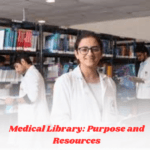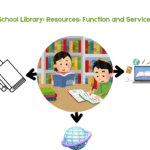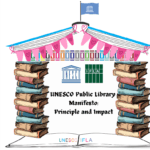Librarians and information scientists believe that if library users can be educated, they can find the information they need on their own. This will not only save their time but also make them feel more comfortable and at ease in using the library. In this way, the principle of ‘use books’ will also be easily implemented. Therefore, the need for library user education is easily understandable.
User education refers to providing systematic knowledge or increasing the skills of library users to find the information they need on their own. Basically, through this type of education, an attempt is made to provide knowledge to the users about how to use the library, how to search for information, library rules and regulations, rules for using reference books, etc.
There was a time when user education was not given much importance. Its importance was not understood, but now in this modern era, it is being considered as a very important issue all over the world, especially in developed countries. And therefore, libraries and information centers of developed countries have taken up various activities to educate users. Users have given importance to it. Users are organizing various seminars and workshops related to education.

User Education Methods:
User education is considered very important, and there is no end to the thoughts of librarians and information scientists on how to educate them. According to most information scientists, user education can be ensured in the following ways:
- Library orientation
- Bibliography instruction
- User awareness
- Programme
- Lecture/Seminar
- Package learning
- Internship assignment
- Personal Assistance
1. Library Orientation: Library orientation is usually more effective in educational institutions in the form of a library. In educational institutions, new students arrive as old students leave. Orientation is organized for new teachers and students. The head of the institution may be present in it. All new students and teachers are present in it. However, old students may be present. Through this, the head or head librarian explains the rules of library usage, the facilities provided by the library, and a brief introduction to the library. An attempt is made to give an idea of what teaching materials are available. Librarians also provide information about catalogs and reference materials. In this way, new students can become aware of the library, and in the same way, they are attracted to the library and come to the library. Gradually, they learn the rules and regulations of using the library, as well as how to find information. Therefore, orientation is considered the main tool of user education.
2. Bibliographic Instruction: The concept of bibliographic instruction has been around since the 20th century. It first began in libraries in educational institutions in the United States.
According to Stevenson, “Bibliography instruction is an instruction to the user of the information resources available in particular subject disciplines and the techniques of using those resources.”
Lewis and Foster consider it “education in the systematic use of information resources.”.
Bibliographic guidance helps users use library resources. It enhances the user’s skills so that they can use information sources independently.
3. User Awareness: Orientation and bibliographic guidance are considered important components of user education. And user awareness is identified as the initial stage. User awareness can be increased by promoting the library and informing the users about the services they can get. In this case, public relations activities can work as an effective element. However, the user must be shown responsibility. They must be passionate about the library. And as a prerequisite for realizing this right, their awareness must be increased.
4. Programme: Libraries and information centers can conduct educational programs. These programs can educate users about library catalogs, bibliographic tools, and other search strategies.
5. Lecture/Seminar: Lecture is a popular teaching method. A seminar is considered more effective than a lecture. By organizing a lecture or seminar, this issue can be discussed openly, and views can be exchanged. This can emerge new ideas about user education.
6. Packaged learning: Packaged learning in a library setting refers to structured educational resources, such as pre-designed modules, digital courses, or curated materials that support user education. Libraries use packaged learning to enhance information literacy, research skills, and lifelong learning opportunities for patrons. These resources can be delivered in various formats, including online tutorials, printed guides, and interactive workshops. By offering packaged learning, libraries ensure accessibility and convenience, enabling users to learn at their own pace. Ultimately, this approach empowers individuals with the knowledge and skills needed to navigate and utilize library resources effectively.
7. Internship assignment: User education in the library is essential for helping patrons effectively locate, evaluate, and use information resources. It includes instruction on library catalog navigation, database searching, citation management, and information literacy skills. Through workshops, online tutorials, and one-on-one guidance, libraries empower users to become independent researchers. This education enhances academic success, critical thinking, and lifelong learning. By fostering information literacy, libraries ensure users can efficiently access and utilize credible resources in an increasingly digital world.
8. Personal Assistance: In libraries and information centers, librarians or other staff can personally teach users how to use the library and where to find the information they need. This is very important, and users benefit from it.
The above-mentioned methods can ensure user education. If any library or information center follows them, then it can be beneficial. As the users will benefit from this, the amount of library usage will also increase. Undoubtedly, the library will be successful.
Importance of User Education
- A library is a vital social institution, primarily responsible for quickly providing access to the information people need. In today’s world, we are experiencing an information explosion, with thousands of new pieces of information produced daily. This makes it increasingly challenging to locate the specific information one seeks. User education is a very effective tool to find the necessary information from this vast ocean.
- When library users are educated about how to navigate these resources, it not only simplifies their experience but also enhances their research activities. By equipping users with the skills to find the information they need independently, libraries help them save time and focus more effectively on their studies and research.
- The user education allows library staff to allocate their time to other essential tasks, improving overall efficiency in the library.
- As a result of the expansion of user education, users can be aware of library resources. As a result, they can help the library in book selection. They can also play a role in preventing unnecessary duplication.
- Maximum use of library materials can be ensured in ensuring maximum use of reading in libraries and information centers. The role of user education is immense. If users can find the information they need themselves, then their interest in reading increases.
User education is essential for empowering individuals with the knowledge and skills to navigate technology, services, or processes effectively, ensuring better engagement and security. By utilizing various methods such as tutorials, workshops, and interactive training, organizations can enhance user experience, reduce errors, and promote long-term success.



